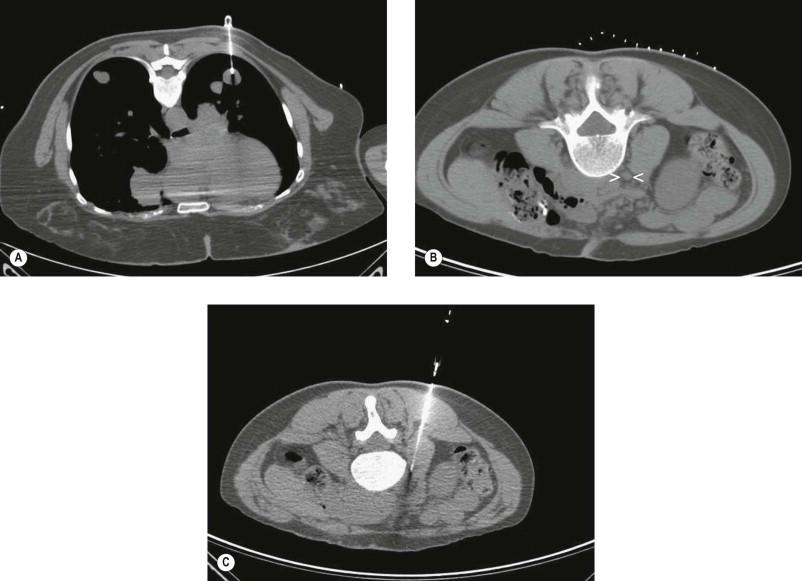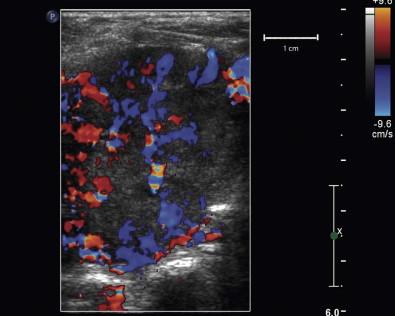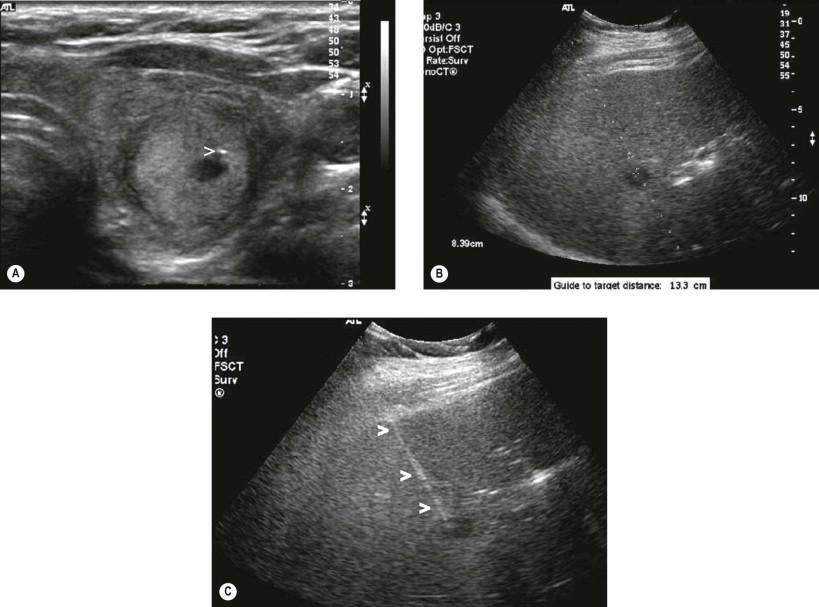Physical Address
304 North Cardinal St.
Dorchester Center, MA 02124
Although modern imaging and laboratory methods permit precise identification of the presence and location of disease throughout the body, cytologic or histologic examination of tissue remains an essential step in establishing a definitive diagnosis and in planning patient management. Tissue sampling by excision or biopsy, coupled with modern methods of tissue processing and examination for specific immunohistochemical markers, plays an important role in the differentiation of benign and malignant disease, and in optimizing therapy for malignancy. The widespread availability of modern imaging equipment has given rise to the adoption of minimally invasive diagnosis of pathology, using the combined skills of the imager, interventionalist, and cytopathologist. Image-guided fine-needle aspiration biopsy (FNAB) can be quickly accomplished with minimal risk and discomfort, avoiding more invasive, risky, and costly procedures for definitive diagnosis.
Image-guided FNAB ideally involves the active participation of a cytopathologist to evaluate the adequacy of specimens as they are obtained. This assures that sufficient cells for diagnosis are obtained with the minimum number of samples, reducing patient risk and discomfort and the inconvenience and anxiety of returning for additional samples if the initial attempts are unsuccessful.
Indications for image-guided percutaneous needle biopsy include, but are not limited to, the following:
To establish the benign or malignant nature of a lesion
To obtain material for microbiologic analysis in patients with known or suspected infections
To stage patients with known or suspected malignancy when local spread or distant metastasis is suspected
To determine the nature and extent of certain diffuse parenchymal diseases.
An ideal method for obtaining tissue samples for analysis should provide high sensitivity and specificity, while minimizing patient risk and discomfort. Modern FNAB, when performed with expert sampling technique and cytologic evaluation, provides these benefits. Lesions not readily palpated require imaging guidance by fluoroscopy, ultrasound (US), computed tomography (CT), or magnetic resonance imaging (MRI). In addition, image guidance is often beneficial in the biopsy of palpable superficial masses. Box 21-1 lists advantages of image guidance for FNAB.
Allows biopsy of lesions not visible or palpable
Provides safe approach for biopsy of deep lesions
Reduces chance of injury to adjacent or overlying structures
Permits confirmation and documentation of sampling location
Allows selection of the sampling site within a lesion to avoid areas of necrosis, etc.
Permits rapid identification of complications.
Allows conversion to core biopsy if necessary
As the availability and capability of CT, US, MRI, positron emission tomography (PET), and PET-CT have grown, lesions previously undetectable are routinely being imaged, creating a need for confirming diagnosis by tissue sampling. Most lesions within the chest, mediastinum, abdomen, or pelvis are accessible for FNAB. Image guidance permits a biopsy approach that minimizes injury to adjacent organs or vessels. Image guidance permits sampling of specific sites within a lesion, targeting areas most likely to contain viable tissue and avoiding areas of suspected necrosis. Imaging allows confirmation and documentation of sampling sites. If FNAB is not adequate for diagnosis, conversion to core biopsy is possible in most instances. Finally, image guidance permits rapid identification and management of complications such as bleeding or pneumothorax, if they arise.
The ideal imaging method for biopsy guidance should provide sufficient resolution to permit the precise identification and localization of small masses embedded in normal organs. High temporal resolution is required to permit real-time or near real-time observation of needle placement. There should be little or no exposure to ionizing radiation and the method should be relatively inexpensive. For use at the bedside or in the operating room, portability is desirable. Although no single imaging method provides all of these attributes, several methods that provide many or most of these advantages are currently available. With the large number of options for performing image-guided biopsy, no single method stands out as better than the others. Selection of the most appropriate approach for a given patient is influenced by many factors, the most important of which is the skill and experience of the individual performing the biopsy with the localization method selected.
In general, imaging methods may be divided into those which provide only 2-dimensional planar information, such as conventional radiography and fluoroscopy, and those providing 3-dimensional cross-sectional imaging capability, namely US, CT, and MRI. The advantages and disadvantages of imaging methods commonly used for FNAB guidance are shown in Table 21-1 .
| Imaging Method | Advantages | Disadvantages |
|---|---|---|
| Fluoroscopy |
|
|
| Computed tomography |
|
|
| Magnetic resonance |
|
|
| Ultrasound |
|
|
Radiography and fluoroscopy utilize X-rays to create a 2-dimensional image by the recording of X-ray energy that passes through the patient onto film or a digital receptor. The image produced is a summation of the superimposed shadows of all structures in the image field, and needle localization in three dimensions is possible only by repositioning the fluoroscope or the patient, or by the use of complex biplane fluoroscopic equipment. Compared to US, CT, and MRI, tissue contrast is poor. Fluoroscopy is best suited for lesions that exhibit high contrast from their surroundings, such as lung or bone masses.
Fluoroscopy provides a dynamic real-time image of the needle and the lesion during manipulation. With fluoroscopy, lengthy or complex procedures may result in significant radiation exposure to the patient. Ability to perform complex angle (e.g., anteroposterior, lateral, or oblique) fluoroscopy views is often necessary to ensure proper needle placement. When using fluoroscopy for FNAB, fluoroscopic time should be kept to a minimum consistent with the “as low as reasonably achievable” (ALARA) radiation safety guidelines.
CT has become an indispensable tool for diagnosis and is an essential tool for guiding FNAB and core biopsy, particularly of deep or inaccessible sites in the mediastinum, abdomen, and pelvis. CT uses X-rays to create high-contrast cross-sectional images of the body, based on the differential X-ray absorption of tissues of differing density. The CT scanner uses a rotating X-ray source to produce radiation that passes through the body onto an array of detectors. The attenuation of the X-ray beam by tissue is continuously measured as the body is passed through the X-ray field. CT produces a series of cross-sectional images through the body, each image representing a slice of tissue measuring only a few millimeters in thickness. The data can be viewed as images in the axial, coronal, or sagittal planes, depending on the diagnostic task. With new multidetector scanners imaging of the entire chest, abdomen, and pelvis is accomplished in a matter of seconds. Cross-sectional imaging provides 3-dimensional spatial localization of a lesion. With newer scanners providing CT fluoroscopy, near real-time image guidance is possible.
Compared with ultrasound, CT is more expensive and may result in significant radiation exposure. The typical radiation dose from a CT examination of the abdomen and pelvis may be from 400 to 500 times greater than that from a chest radiograph. Therefore, when using CT for biopsy guidance, care must be taken to keep exposure of the patient and operator to a minimum. In addition, iodinated contrast agents may be required to provide adequate imaging of some masses. CT guidance is particularly valuable in patients with lesions that are difficult to access or are in precarious locations ( Fig. 21-1 ). CT is less operator-dependent than US and is preferred if an experienced US interventionalist is not available.

MRI uses radiofrequency energy to generate cross-sectional images, but, unlike CT, does not utilize ionizing radiation. Both CT and MRI scanners can generate multiple 2-dimensional cross-sectional slices of tissue and 3-dimensional reconstructions. Tissue contrast with MRI is based on the interaction of the magnetic field and radiofrequency pulses with protons, an interaction fundamentally different from that used in CT and US, and therefore capable of showing lesions not detectable with other methods. MRI provides excellent contrast and spatial resolution, but is more expensive than CT. MRI-guided biopsy is complicated by the fact that special equipment not affected by the magnetic field of the scanner must be used. MRI guidance is generally limited to biopsy of lesions that cannot be adequately imaged by CT or US, usually in the breast.
US is the most versatile of imaging methods used for biopsy guidance. The equipment is portable and permits the use of transrectal, transvaginal, and endoscopic approaches. US uses high-frequency (3–15 MHz) acoustical energy to provide real-time, high-contrast images throughout the body. Images are produced by the reflection of sound from tissue interfaces. No radiation is used and there are no known risks for patients or equipment operators. Like CT and MRI, ultrasound produces thin cross-sectional images of the body, but, unlike these methods, the ultrasound transducer can be positioned to scan in virtually any image plane. Because ultrasound imaging is not constrained by a gantry or magnet bore, angled approaches to lesions are facilitated. Images are updated from 15 to 60 times per second, permitting real-time imaging of needle position and target motion.
In addition to soft tissues, vascular structures may also be imaged in real time without the need for contrast administration through the use of color or power Doppler ( Fig. 21-2 , see Video 21.1). The combination of real-time imaging, high-contrast display of tissue and blood flow, portability, low cost, and safety make ultrasound an excellent method for guiding FNAB in all areas of the body in which imaging is not impeded by overlying bone, gas, or excessive depth ( Fig. 21-3 ).


Positron mission tomography (PET) produces images based on the uptake of positron-emitting radionuclides introduced into the body on a biologically active molecule. The molecule most commonly used for this purpose is fluorodeoxyglucose (FDG), a sugar utilized by metabolically active tissues, including many tumors. Small tumors undetectable by conventional imaging methods may be identified with PET scanning. Although not used for image guidance, PET images are often fused with CT images to permit more precise localization. This may then facilitate image-guided biopsy with CT or US.
Become a Clinical Tree membership for Full access and enjoy Unlimited articles
If you are a member. Log in here